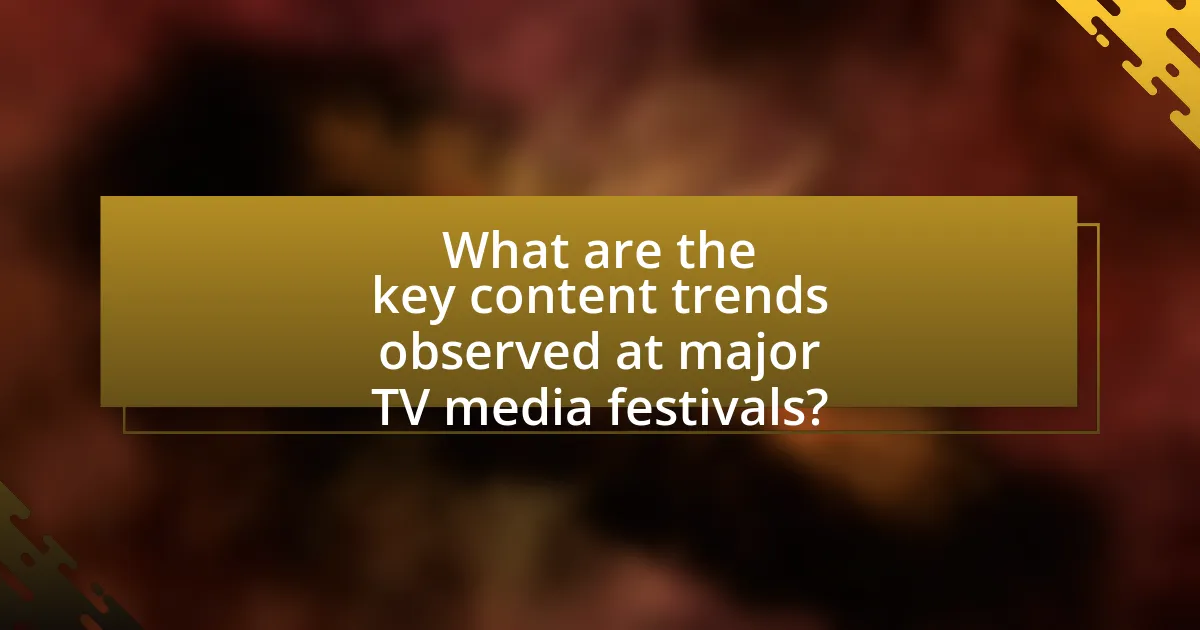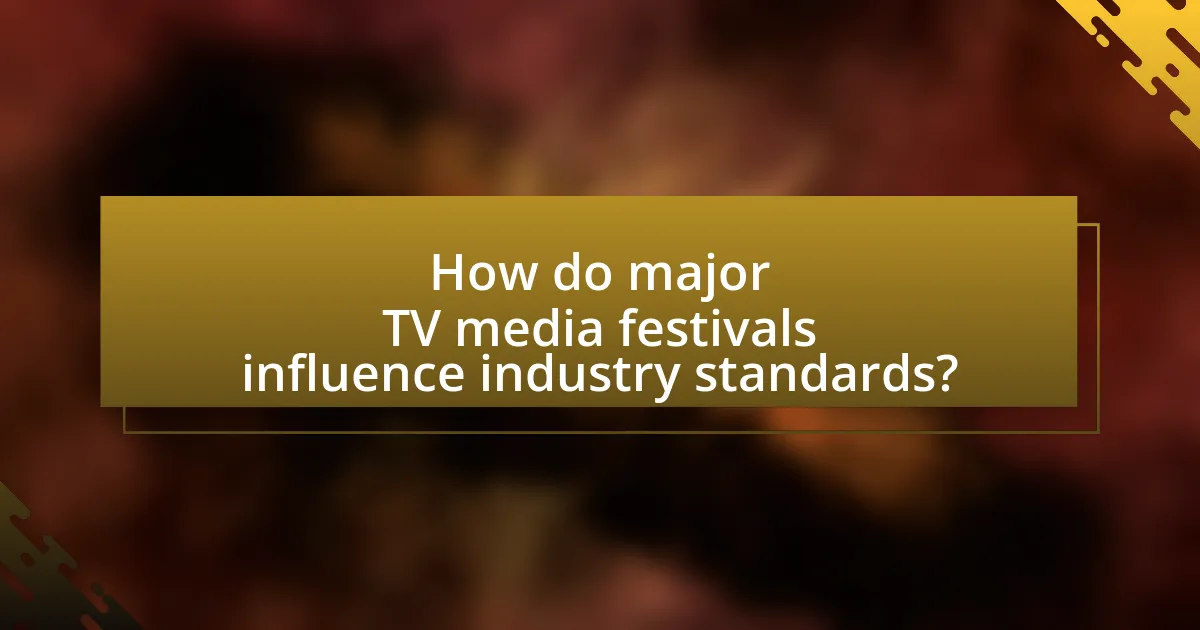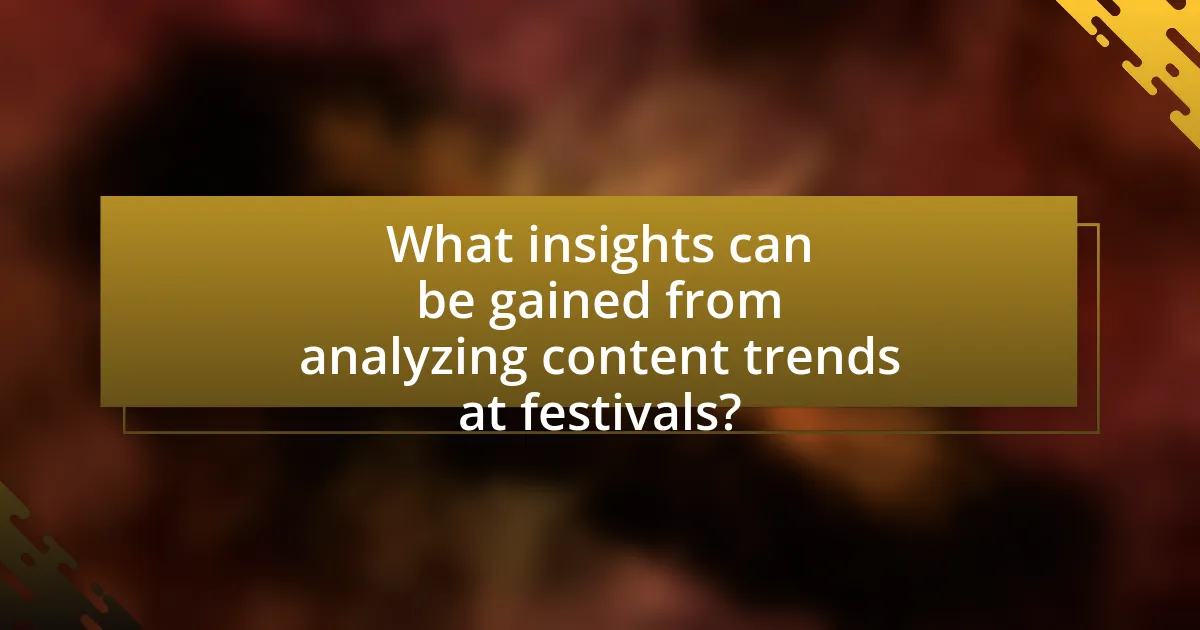The article analyzes key content trends observed at major TV media festivals, highlighting the emphasis on diverse storytelling, innovative formats, and technological integration. It discusses how these trends reflect shifts in audience preferences towards inclusivity and on-demand content consumption, as well as the rising popularity of specific genres such as drama, documentary, and reality television. Additionally, the article examines the evolving storytelling techniques influenced by audience feedback, the impact of technological advancements on content distribution, and the role of festivals in shaping industry standards and providing opportunities for new talent. Insights into how creators can leverage these trends for their projects and marketing efforts are also explored.

What are the key content trends observed at major TV media festivals?
Key content trends observed at major TV media festivals include a significant focus on diverse storytelling, innovative formats, and the integration of technology. Festivals such as the Cannes Series and MIPCOM have highlighted the rise of narratives that reflect varied cultural perspectives, with an emphasis on inclusivity and representation. Additionally, there is a growing trend towards shorter, episodic formats that cater to changing viewer habits, as evidenced by the popularity of limited series. The incorporation of advanced technologies, such as augmented reality and interactive content, has also been a prominent theme, showcasing how creators are adapting to enhance viewer engagement. These trends are supported by industry reports indicating that diverse content and technological innovation are driving audience interest and engagement in contemporary television.
How do these trends reflect changes in audience preferences?
Trends in content from major TV media festivals reflect significant shifts in audience preferences towards diversity, authenticity, and digital engagement. For instance, the increasing representation of underrepresented groups in storytelling indicates a demand for more inclusive narratives, as evidenced by the rise in shows featuring diverse casts and perspectives, which have been shown to attract broader viewership. Additionally, the popularity of interactive and streaming formats highlights a preference for on-demand content consumption, aligning with data that shows over 70% of audiences favor binge-watching series. These trends collectively demonstrate that audiences are seeking more relatable, varied, and accessible content, driving creators to adapt their offerings accordingly.
What specific genres are gaining popularity at these festivals?
Specific genres gaining popularity at major TV media festivals include drama, documentary, and reality television. Recent trends indicate that drama series, particularly those with strong character development and complex narratives, have seen increased viewership and critical acclaim. Documentaries focusing on social issues and true crime have also captured audience interest, reflecting a growing demand for informative and engaging content. Reality television continues to thrive, with formats that emphasize competition and personal stories resonating well with festival attendees and viewers alike. These trends are supported by data showing that drama and documentary categories have received more nominations and awards at recent festivals, indicating their rising prominence in the industry.
How are storytelling techniques evolving in response to audience feedback?
Storytelling techniques are evolving through the integration of audience feedback, leading to more interactive and personalized narratives. Content creators are increasingly utilizing data analytics and social media interactions to gauge viewer preferences, which informs the development of plotlines, character arcs, and pacing. For instance, platforms like Netflix analyze viewer engagement metrics to adjust series trajectories, resulting in tailored content that resonates with specific demographics. This shift towards audience-centric storytelling is evident in the rise of participatory formats, such as choose-your-own-adventure narratives, which allow viewers to influence story outcomes directly.
What role do technological advancements play in shaping content trends?
Technological advancements significantly influence content trends by enabling new formats, enhancing distribution methods, and facilitating audience engagement. For instance, the rise of streaming platforms has transformed how content is consumed, leading to a shift from traditional broadcasting to on-demand viewing. According to a report by Deloitte, 70% of consumers prefer streaming services over cable, highlighting the impact of technology on viewer preferences. Additionally, advancements in artificial intelligence and data analytics allow content creators to tailor their offerings based on audience behavior, further shaping trends. This data-driven approach has been shown to increase viewer retention and satisfaction, demonstrating the critical role technology plays in evolving content landscapes.
How is streaming technology influencing festival content selections?
Streaming technology is significantly influencing festival content selections by enabling broader access to diverse programming and facilitating real-time audience engagement. Festivals are increasingly curating content that appeals to global audiences, as streaming platforms allow for immediate distribution and feedback, which informs future selections. For instance, the rise of platforms like Netflix and Hulu has led festivals to prioritize original content that showcases unique storytelling and innovative formats, reflecting viewer preferences and trends identified through streaming data analytics. This shift is evident in festivals such as Sundance and Tribeca, which now feature more digital-first projects, aligning with the consumption habits of audiences who favor on-demand viewing over traditional broadcast schedules.
What impact do social media platforms have on content visibility during festivals?
Social media platforms significantly enhance content visibility during festivals by facilitating real-time engagement and sharing among users. During major events, platforms like Instagram, Twitter, and Facebook allow users to post updates, photos, and videos, which can rapidly spread to a wider audience. For instance, a study by the Pew Research Center found that 69% of adults in the U.S. use social media, and during events, posts can reach millions within hours, amplifying the visibility of festival-related content. Additionally, hashtags and trending topics on these platforms create a centralized space for discussions, further increasing the discoverability of content associated with festivals.

How do major TV media festivals influence industry standards?
Major TV media festivals influence industry standards by showcasing innovative content and setting benchmarks for quality and creativity. These festivals, such as the Cannes Lions and the Emmy Awards, serve as platforms where industry leaders gather to highlight emerging trends, technologies, and storytelling techniques. For instance, the Cannes Lions has historically recognized groundbreaking advertising and content strategies, prompting networks and production companies to adopt similar high standards in their own projects. Additionally, awards and recognition at these festivals often drive competition, encouraging creators to push boundaries and elevate the overall quality of television programming. This dynamic not only shapes audience expectations but also influences funding and distribution decisions within the industry.
What are the criteria for content selection at these festivals?
The criteria for content selection at major TV media festivals typically include originality, relevance to current trends, audience engagement potential, and production quality. Festivals prioritize unique narratives that resonate with contemporary societal issues, ensuring that selected content can captivate viewers and stimulate discussions. Additionally, high production values and technical excellence are essential, as they reflect the professionalism expected in the industry. These criteria are supported by the festival’s mission to showcase innovative storytelling and elevate diverse voices within the media landscape.
How do festival awards affect the careers of content creators?
Festival awards significantly enhance the careers of content creators by providing recognition, credibility, and networking opportunities. Winning or being nominated for prestigious awards can lead to increased visibility, attracting potential collaborators, sponsors, and audiences. For instance, a study by the University of Southern California found that award-winning filmmakers often experience a 50% increase in project funding and distribution opportunities following their accolades. This recognition not only validates their work but also positions them favorably in a competitive industry, ultimately leading to more significant career advancements and opportunities for future projects.
What trends in diversity and inclusion are emerging from festival selections?
Emerging trends in diversity and inclusion from festival selections indicate a significant increase in representation across various demographics, including race, gender, and sexual orientation. For instance, recent festivals have showcased a higher percentage of films directed by women and people of color, reflecting a broader commitment to inclusivity. According to the 2022 Sundance Film Festival, 45% of the films selected were directed by women, a notable increase from previous years. Additionally, LGBTQ+ narratives have gained prominence, with festivals like Tribeca highlighting stories that center on diverse sexual identities. This shift not only enhances the visibility of underrepresented groups but also aligns with audience demand for more authentic and varied storytelling.
How do festivals serve as a platform for new talent?
Festivals serve as a platform for new talent by providing exposure, networking opportunities, and access to industry professionals. These events often feature showcases where emerging artists can present their work to a diverse audience, including potential collaborators and investors. For instance, the Sundance Film Festival has been instrumental in launching the careers of numerous filmmakers, with over 200 films premiering there that later gained critical acclaim and commercial success. Additionally, festivals often include panels and workshops led by established industry figures, allowing new talent to gain insights and make valuable connections that can lead to future projects.
What opportunities do festivals provide for emerging creators?
Festivals provide emerging creators with networking opportunities, exposure to industry professionals, and platforms to showcase their work. These events facilitate connections with potential collaborators, investors, and mentors, which can lead to future projects and career advancements. For instance, the Sundance Film Festival has been known to launch the careers of numerous filmmakers by providing them with access to influential figures in the film industry. Additionally, festivals often include workshops and panels that offer valuable insights into industry trends and best practices, further enhancing the skill set of emerging creators.
How do networking events at festivals contribute to industry growth?
Networking events at festivals significantly contribute to industry growth by facilitating connections among professionals, fostering collaboration, and promoting innovation. These events create opportunities for industry stakeholders, such as producers, writers, and distributors, to meet face-to-face, share ideas, and explore potential partnerships. For instance, the 2022 Cannes Film Festival reported that over 10,000 industry professionals attended, leading to numerous deals and collaborations that enhanced the global film market. Such interactions not only stimulate creative projects but also drive economic growth within the industry by increasing the production of content and expanding distribution networks.

What insights can be gained from analyzing content trends at festivals?
Analyzing content trends at festivals reveals audience preferences, emerging genres, and innovative storytelling techniques. By examining the types of content that gain traction, stakeholders can identify what resonates with viewers, such as the popularity of specific themes or formats. For instance, data from the 2022 Cannes Film Festival indicated a significant rise in interest for documentaries, reflecting a broader societal trend towards non-fiction storytelling. Additionally, analyzing social media engagement during festivals can provide insights into real-time audience reactions, helping creators and marketers tailor their strategies effectively.
How can content creators leverage festival trends for their projects?
Content creators can leverage festival trends for their projects by analyzing audience preferences and emerging themes showcased at these events. Festivals often highlight innovative storytelling techniques, popular genres, and cultural shifts, which can inform creators about what resonates with viewers. For instance, the rise of documentary formats at festivals like Sundance indicates a growing audience interest in real-life narratives, prompting creators to explore similar themes in their work. Additionally, networking opportunities at these festivals allow creators to collaborate with industry professionals, enhancing their projects with fresh perspectives and insights.
What strategies can be employed to align with current audience interests?
To align with current audience interests, content creators should employ data-driven audience analysis, which involves utilizing analytics tools to track viewer preferences and engagement metrics. By analyzing data from social media, streaming platforms, and viewer surveys, creators can identify trending topics and genres that resonate with their audience. For instance, a report from Nielsen indicates that 70% of viewers prefer content that reflects their personal experiences and cultural backgrounds, highlighting the importance of relevance in content creation. Additionally, engaging with audience feedback through comments and social media interactions allows creators to adapt their content strategies in real-time, ensuring alignment with evolving interests.
How can understanding festival trends enhance marketing efforts?
Understanding festival trends can significantly enhance marketing efforts by allowing brands to align their strategies with audience interests and behaviors. By analyzing data from major TV media festivals, marketers can identify popular themes, genres, and content formats that resonate with viewers. For instance, the rise of streaming platforms has shifted audience preferences towards binge-worthy series, which can inform promotional strategies. According to a report by Nielsen, 70% of viewers prefer watching series in one sitting, indicating a trend that marketers can leverage to create targeted campaigns. This alignment with audience preferences not only increases engagement but also improves the effectiveness of marketing initiatives, ultimately driving higher conversion rates.
What are the best practices for engaging with festival content trends?
The best practices for engaging with festival content trends include actively monitoring social media platforms, participating in discussions, and analyzing audience feedback. Engaging with social media allows content creators to identify trending topics and popular themes emerging from festivals, as platforms like Twitter and Instagram often showcase real-time reactions and highlights. Participation in discussions, whether through panels or online forums, fosters connections with industry professionals and provides insights into current trends. Analyzing audience feedback through surveys or comment sections helps gauge viewer preferences and adapt content strategies accordingly. These practices are supported by data indicating that 70% of content creators who engage with audience feedback see improved viewer retention and satisfaction.
How can creators effectively adapt their work to meet evolving trends?
Creators can effectively adapt their work to meet evolving trends by continuously researching audience preferences and industry developments. This involves analyzing data from viewership statistics, social media engagement, and feedback from major TV media festivals, which often showcase emerging themes and innovative storytelling techniques. For instance, a report from the 2023 Cannes Series Festival highlighted the rising popularity of interactive content, indicating a shift in audience expectations towards more immersive experiences. By integrating such insights into their projects, creators can align their work with current trends and enhance viewer engagement.
What common pitfalls should be avoided when following trends?
Common pitfalls to avoid when following trends include overreacting to fleeting fads, neglecting audience preferences, and failing to conduct thorough research. Overreacting to fleeting fads can lead to misallocation of resources, as trends often change rapidly; for instance, a study by the Harvard Business Review highlights that 70% of new product launches fail due to lack of market understanding. Neglecting audience preferences can alienate core viewers, as evidenced by the backlash against shows that stray too far from established themes. Lastly, failing to conduct thorough research can result in missed opportunities or misinterpretations of trends, as demonstrated by Nielsen’s findings that data-driven decisions significantly outperform intuition-based strategies in content creation.

Leave a Reply